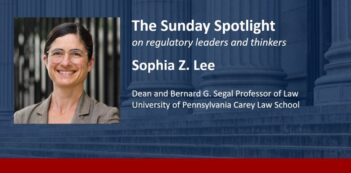
Legal scholar makes the case for courts deferring to agency’s trademark determinations.
Trademarks are valuable economic rights. Businesses around the world use trademark status to guard their investments in their brands and prevent counterfeiters from profiting at their expense. Consumers also gain when trademarked terms and images can serve as symbols of product quality; without the protection of trademark law, consumers would have a difficult time distinguishing original brands from their imitations, and consumer trust in the products they buy would diminish or even disappear altogether.
Despite trademarks’ importance to the global economy, the federal court that hears most trademark registration disputes is overlooking important Supreme Court decisions affecting the outcomes of those cases, writes Professor Melissa Wasserman of the University of Illinois College of Law in a forthcoming paper.
Wasserman argues that the U.S. Court of Appeals for the Federal Circuit – which reviews the majority of U.S. Patent and Trademark Office decisions about the awarding of federal trademark protection– is misapplying the Supreme Court’s administrative law rulings. According to Wasserman, the Federal Circuit has been deciding its trademark cases as if those Supreme Court decisions do not apply to trademark law and, in the process, has given the PTO’s views insufficient respect.
Wasserman’s argument focuses on the relationship between the Federal Circuit and the PTO. Before a case ends up in the Federal Circuit, the PTO reaches its decision about whether a product’s name or symbol meets the federal trademark registration requirements. As part of its proceedings, the PTO makes a lot of fact-based judgments – for example, whether a name or symbol is distinctive, which it must be to qualify for registration.
The PTO also engages in a fair amount of legal interpretation. In deciding when to grant or deny trademark registration, the PTO looks to the federal law known as the Lanham Act. However, as Wasserman points out, the Lanham Act is far from clear: its requirements are open to generous interpretation.
This is where the Supreme Court’s administrative law rulings come into play. Those rulings establish that when reviewing an agency’s factual determinations, federal courts should generally accept them as true. Likewise, when reviewing an agency’s interpretation of a statute that Congress has charged it with administering, federal courts should take the agency’s interpretation seriously. If a court follows the principles laid down in past Supreme Court decisions, it should generally accept the agency’s interpretation of a statute. Unless the statute is crystal clear, the agency’s interpretation should stand, even if the court acting on its own might have interpreted the statute differently.
In Wasserman’s view, the Federal Circuit has failed to follow this approach when reviewing the PTO’s factual and legal judgments. She argues that the Federal Circuit is less deferential to the PTO than the Supreme Court’s decisions say it should be. Indeed, the Federal Circuit, she asserts, has effectively adopted a “zero-deference” approach when reviewing PTO decisions. By simply ignoring the PTO’s interpretations, the Federal Circuit is itself acting contrary to law.
The Federal Circuit’s zero-deference approach is also undesirable as a matter of policy, according to Wasserman. As an institution, the PTO is more capable than a court to understand how to realize the goals of trademark law, namely to protect business investments and curtail consumer deception. As an administrative agency, the PTO has the ability to collect needed consumer behavior data and cultivate the expertise to analyze that data. The courts, by contrast, lack this kind of expert capacity, serving a more passive role in settling disputes and examining only the evidence brought before them.
Ultimately, Wasserman endeavors to bring the U.S. trademark system under the purview of contemporary administrative law, which recognizes the merits of agency-driven policy and accepts the limitations of courts in seeing that the will of Congress is fulfilled.



